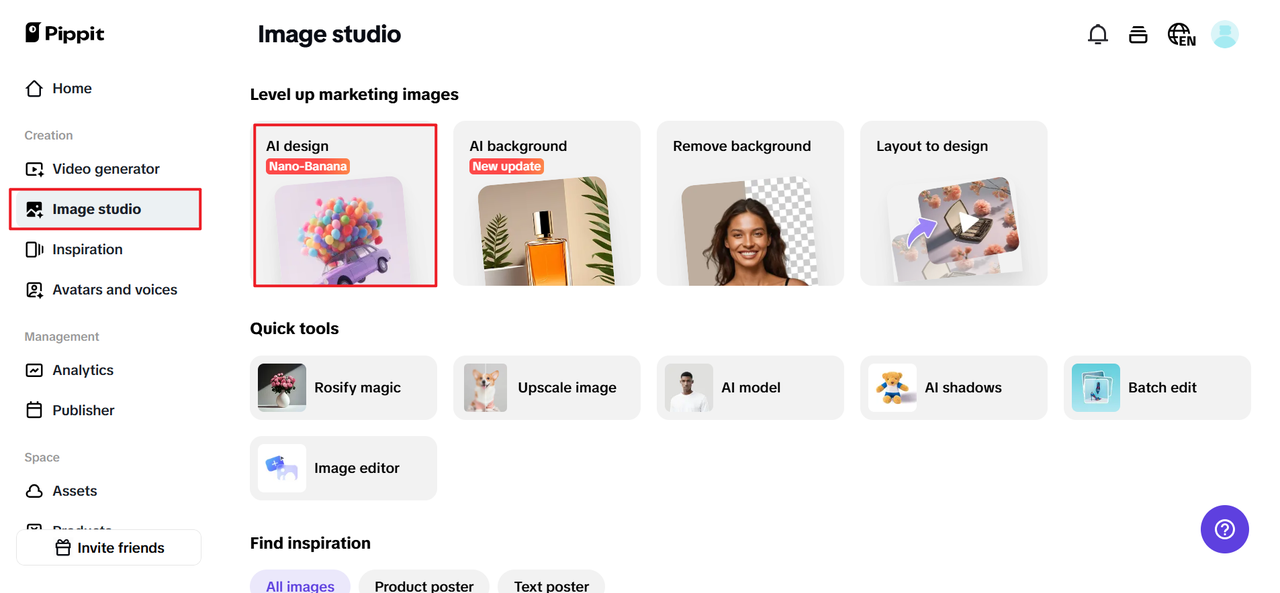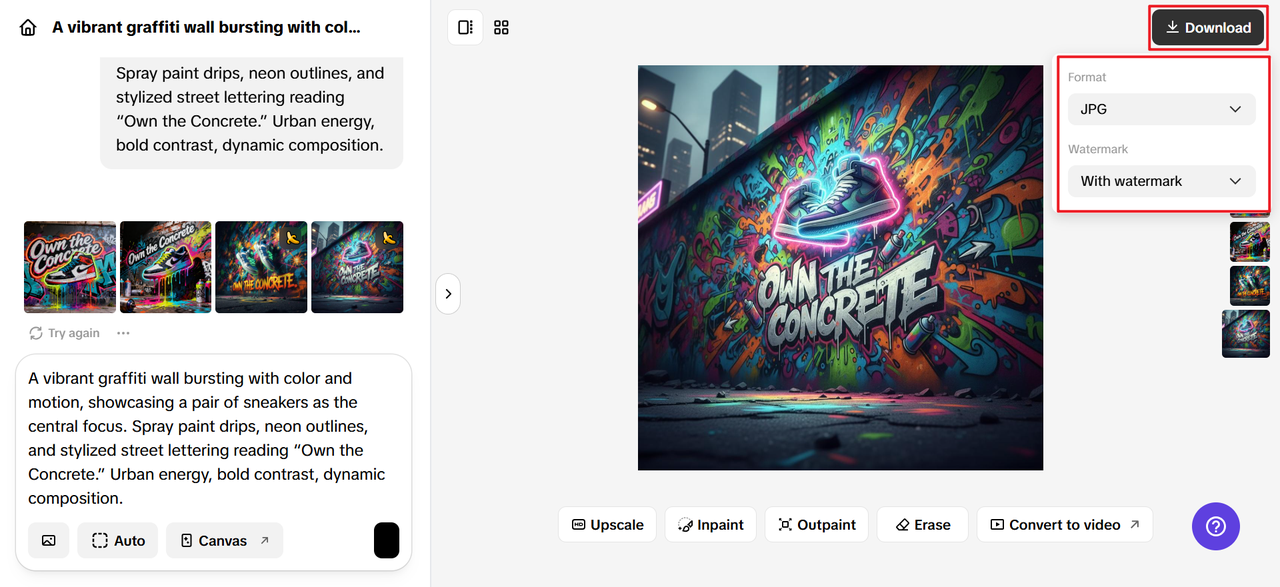No longer merely a background, the digital wall is now a stage. Graffiti generation tools are being used by artists, designers, and marketers to combine rebellion with design thinking, developing campaigns that are spontaneous-feeling, human, and raw — even in digital form.

When rebellion clashes with resolution: the future graffiti landscape
Graffiti in the digital space isn't about domesticating street art; it's about liberating it from walls. Once the icon of city rebellion, graffiti now has a second home in virtual reality — from digital posters and album covers to experiential AR campaigns and NFT art collections. It's a visual language that continues to speak rebellion, but in pixel form.
The distinction? Reach and reinvention. Where old-school graffiti gets wiped out behind urban clean-up crews or burned off by the sun, virtual graffiti thrives everywhere — across timelines, store fronts, and augmented environments. With software such as Pippit, anyone can dabble in graffiti-style layers, gradients, and textures that replicate the grime of actual paint, without the slightest splash of aerosol.
From walls to screens: the graffiti renaissance of digital creators
There's an interesting transformation that's taking place — street art is no longer public art; it's shared art. The virtual graffiti revolution provides artists with unlimited space and freedom to imagine. Rather than competing for wall space, they're pushing the boundaries of layering, animation, and illogical composition in cyberspace.
This releases wild new possibilities. Think of graffiti that animates when you scroll, transforms into a different color depending on how you touch it, or evolves into music when you watch a video. It's expressive, dynamic, and intensely personal — combining urban beauty with the storytelling ability of digital media.
And most importantly, perhaps, this transformation keeps the spirit of rebellion alive. Graffiti has never been about visibility — asserting a voice where it does not belong. Now, visibility is increased through each post, reel, or ad banner that bears a digital stamp.
The creative edge: why designers are embracing digital graffiti
Designers in fashion and advertising, they are picking up this fresh vibe from graffiti's wild, expressive side. You know, that whole spontaneous thing with hand-drawn tags and paint splatters everywhere. It is like an antidote to all the super polished minimalism that rules modern design these days.
A designer brand might slap on some digital graffiti overlays for a campaign that looks all rough and ready. Or take a movie studio, they could layer street-style typography right over a scene to amp up the mood and that edgy attitude. Even luxury brands are getting in on it, kind of dancing along the edge by mixing graffiti art with high-fashion photography. They aim for this harmony between rebellion and elegance, you see.
And if someone wants to crank it up more, a low quality image maker can throw in just enough grain and compression. That mimics the charm of old school underground street photography, basically. The end result turns into this layered visual story. It feels raw and emotional, alive in a way.
Reimagining the streets: graffiti's new digital playground
On this new digital street, every platform is a wall. Instagram grids are murals. YouTube intros turn into digital tags. TikTok transitions are graffiti fades and sprays. Even the metaverse has virtual districts where graffiti art is included in immersive brand experiences.
But it's not like old graffiti, where it was destruction — it's creation. Artists are creating new visual environments that embrace reality and fantasy. Some design graffiti that responds to motion sensors in AR filters. Others work together across continents, creating digital walls in collaborative 3D environments.
It's a rebellion that is both futuristic and supremely nostalgic. The subversive core of graffiti — the desire to be seen — continues to beat like ever, but now it runs through lines of code rather than strokes of paint.
How to make digital graffiti posters with Pippit
If you've ever dreamed of creating graffiti artwork without the hassle or limitation of real space, Pippit makes it elegantly simple. With its easy online graffiti maker, you can bring your concepts to life as gorgeous posters or brand images within minutes. Here's how to create your digital graffiti:
Step 1: Choose "Poster" from the Image Studio
Click "Image Studio" in Pippit's left panel. Select "Poster" to design a fully customized AI graffiti poster. This space helps create visually strong graffiti images with a professional feel, regardless of whether you're designing a street-influenced brand image, musician promotion, or a digital mural.

Step 2: Compose your concept and create
Type in your concept into the prompt window at the left side panel - it could be "spray-paint logo on cracked concrete wall" or "neon graffiti on dark brick with bold street typography". For added precision in the design, flip on "Enhance prompt." Select the type of poster (product or creative), and choose the graffiti type, then click "Generate." See Pippit create your vision in seconds.

Step 3: Pick, edit, and finalize your design
Browse the graffiti posters you have created and select one that most complements your theme. Go ahead and tap the design you want to import to the canvas, so you can re-arrange it, adjust color shades, or add your own text. Once you fix your design in the way you feel it is correct, select the "Download" option for your virtual graffiti artwork — all set for marketing campaigns, social media posts, or if you just want to exhibit it online!

Beyond the spray: where digital graffiti is going next
We are entering a time when graffiti isn't simply visual art — but experiential narrative. Artists are combining 3D modeling, motion graphics, and AR to make multi-sensory graffiti experiences. Soon, you may be walking through a virtual alleyway that responds to your presence — or tapping on a virtual mural to reveal secrets.
Brands are joining the fray as well. Graffiti-styled artwork is being used in street-style advertising to appeal to audiences who are looking for authenticity. Independent artists are employing graffiti lettering to create digital zines and album covers that are distinct from sterile, AI-treated designs. It's a heady back-and-forth between rebellion and technology — chaos and control.
Pippit: where digital walls become your creative playground
Ultimately, the history of graffiti is unchanged — a message scrawled boldly where it's not expected. What's different is the wall. With Pippit, painters no longer require a street corner or underpass. They've got an endless digital city to play with — full of light, texture, and movement.
So take your concept, fire up Pippit's graffiti maker, and tag your imagination onto electronic skies. Because these days, the wall is wherever you are — and the artwork never wears off.
Make your graffiti masterpiece with Pippit — where each click is a spray, and each design shares your tale!